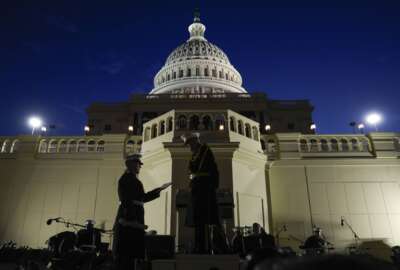There’s one big population the Department of Government Efficiency might be overlooking
The Department of Government Efficiency, or DOGE, might be overlooking another source of savings: government contractors outnumbering federal employees.
The Department of Government Efficiency, or DOGE, has vowed to help the Trump administration reduce the federal headcount. My next guest says the DOGE might be overlooking another source of savings: government contractors outnumbering federal employees. Danielle Brian, executive director of the Project on Government Oversight, joined the Federal Drive with Tom Temin to discuss.
Interview transcript:
Tom Temin: And of course, you and I have both been watching this stuff for more decades than we care to admit. And DOGE is an interesting development because it’s external and yet it has this kind of wry tongue-in-cheek almost name department. And your assessment is what of DOGE? What is what is POGO thinking about this?
Danielle Brian: Well, I mean, I think it needs to be said that I have real concerns about the fact that because specifically Musk is not going to be captured by any of the general conflict of interest rules in the role that he would be playing. I have real concerns about the conflict of interest posed by someone who is in the middle of running a variety of companies while he’s in a role advising the president on really significant matters that he has a financial conflict of interest in.
Tom Temin: Yes, he is a contractor at SpaceX.
Danielle Brian: He’s not only a contractor. So he has that world of issues that are very clearly intertwined. But then he also is going to be in a role where he’s going to be advising who are the right regulators in many of those commissions that will be appointed by the president and boards that are going to be making decisions on other parts of his portfolio like crypto and social media. So it’s such a wide array. We’ve never seen this kind of conflict before, frankly.
Tom Temin: Right. And they are looking at the federal bureaucracy. And I guess let me postulate this for you, they’re looking at the size of the headcount. There’s 2.1 million, I think roughly plus or minus, federal employees now. And that’s been a pretty steady constant for many, many years. And to cut the workforce would seem to be admitting you have to bring in more contractors in less functions go away.
Danielle Brian: There’s no question that I think they’re looking in the wrong direction when they keep talking about federal employees as the place to save money. First of all, even if we got rid of all the federal employees, we wouldn’t be saving as much money as they’re intending to say. Secondly, that has, as you pointed out, we’ve had a cap, generally speaking, on the size of the federal workforce, but not a cap on the size of the contractor workforce or the money spent on those contractors and the contracts that they manage. And so one of our priorities this month and the next couple of months is going to be laying out if you really want to save money, we have ideas. It’s really not looking at the federal workforce and cutting that back.
Tom Temin: Yes. So what are some of those things? I mean, there’s the duplication list of the GAO, a lot of publicly available sources.
Danielle Brian: There’s certainly those kinds of sources that are right there and have been, as you mentioned, and frankly, for decades, being recognized. There’s also not just who is on the payroll, but also how the contracts are structured. Some of the really nerdy stuff that we know we’ll save so much money is, for example, the fact that we have expanded the use of commercial item contracting as a way to, this goes back to the Clinton administration and reinventing government, which you were around for, it was supposed to reduce red tape, but what it did in the end was allow contractors to get away with, frankly, not giving the kind of cost and pricing data that government contracting officers need to know that information to know whether we’re getting a good price for what we’re buying, what the government is buying with those dollars. That is, to me, maybe one of the more important ways we could get some of the price gouging that we’ve seen over the years under control.
Tom Temin: And those contractors that are working under other transaction authorities that is outside of the Federal Acquisition Regulation, are starting to say, ‘Golly, we’re seeing cost and price information coming in to contracts for OTA and we don’t like it.’
Danielle Brian: That’s right. That’s absolutely right. OTA was another one of those things that I remember testifying way back, like, what are we doing here? We’re creating a huge loophole. And so these are the things that are really nerdy, but I think could really significantly capture some of the big dollars that DOGE is intending to look at.
Tom Temin: We’re speaking with Danielle Brian, executive director of the Project on Government Oversight. But by the same token, the complexity of the FAR does make things go slow for the government and that in turn increased costs on the contracting community. And it also keeps some small innovation companies from coming into the market saying who needs all this to sell something?
Danielle Brian: I think there’s no question that the system that we have now is benefiting the Big 5 or whatever we want to call the big contractors at the expense of the kinds of new industries, especially the tech world, the small companies, from being able to compete. And that’s one of the things that I think we might be on the same playing field with them is what we have now is not really an even playing field in the contracting community and that should be part of the change.
Tom Temin: All right. And then what’s your sense of the size of the contracting workforce? I mean, they assign a certain number of people to a given project for the government, and the price becomes the cost becomes dependent on that. No one’s ever really looked at, does it take this many people to do this or not? It could be they don’t have enough people on contracts, and so they go longer and cost more than if they cost more per hour but were over faster or something.
Danielle Brian: That makes sense. But I will say that POGO and it was way back and I think 2011, we did a study that I’m still very proud of that looked at it a different way. We took and did as much as we could, apples-to-apples comparisons of the cost to the government of a federal employee fully loaded with benefits, the cost to the government of a contractor doing that same job and what it cost in the private sector because there’s always this perception and that’s what the reinventing government had been based on, this concept that the private sector does things faster and cheaper. And what we found was an apples-to-apples comparison. It is true that things often are less expensive in the private sector, but if you’re looking at the same job, government contractor versus federal employee to the government, it is typically as much as three times more expensive to the government, to the taxpayer, to have a contractor doing the same work. That to me is at the heart of what I want us to really get a handle on. The theory behind keeping the size of the federal workforce down as a way of saving money is just a failed concept.
Tom Temin: So I wonder if A-76 competitions should return. They’ve been banned now for a long time. That would be the proof that contracting is more expensive if it comes out right. If everyone does it according to the, you know, good accounting standards.
Danielle Brian: That’s true. I will say that I know that the federal unions had a lot of concerns about the process of A-76, but I think in the end, something like that is what we need to do. We really need to do a much more serious analysis and not just based on assumptions that the private sector is less expensive to the government because it’s not.
Tom Temin: And so many organizations like POGO and other nonprofits are looking at defense contracting and looking at these kind of gilded programs they’re building or trying to build. And you look at, say, China turning out ship after ship after ship. And we have ships that are 10, 12 years from keel laying to floating and then another 10 years till acceptance. And that’s what it takes. It’s 20 years from a carrier to the first rivet till somebody says, “OK, now we can use this thing as a warship.’ What about all that complex?
Danielle Brian: Well, and you didn’t mention the last part of that is by the time that happens and the systems that aren’t working well, we often mothball or retire them almost as soon as they’re made available. We saw that with the littoral combat ship. I mean, it’s a real failure of multiple systems. But I would say that world in particular, what I’m really interested in is looking at the role that the Congress doesn’t yet play but should in moving towards the decision of full right to production and the role of operational testing and the decisions around whether something’s working or not before we’re buying many of those items, those huge ticket items.
Tom Temin: It seems as if we have approached defense contracting as a rich nation only can and maybe as a rich nation, we’d get more if we approached it as a poor nation.
Danielle Brian: Or as just any normal person would. If we think about it in our own pocketbooks, would we be spending a huge chunk of our budget on something we’re not sure if it works or not yet? No, of course we wouldn’t. We need to sort of reset the prioritization of when we decide we’re going to put a lot of money into a program.
Tom Temin: And we should point out that you are expanding POGO’s own offerings in the training area. You have been for many years teaching congressional staffers on the art of oversight. Now you’re looking at the executive branch federal workforce.
Danielle Brian: That’s right. I will say I was very excited just this past week. We held our training on how to have meaningful confirmation hearings. And we had, I think, over 160 Senate staff attend. It’s always bipartisan. It’s all about making sure we’re doing the job well and we’re getting the meaningful information out in these oversight hearings. We’re now pivoting, looking at the federal workforce and how we could complement our offerings for the federal workforce, both on their rights and responsibilities as federal employees in a time when we definitely have an administration coming in that is hostile to the workforce. So that’s something that I hope your listeners will be looking to us for in the next few in the next couple of months, I would say.
Copyright © 2025 Federal News Network. All rights reserved. This website is not intended for users located within the European Economic Area.
Tom Temin is host of the Federal Drive and has been providing insight on federal technology and management issues for more than 30 years.
Follow @tteminWFED






